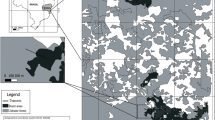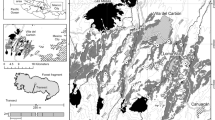Abstract
Hard (high-contrast with pastures) and soft (low-contrast with old-fields) forest edges created by slash-and-burn agriculture have become common landscape features in regions dominated by neotropical montane forest. However, little is know about the impacts of such edge types on forest regeneration dynamics. The consequences of varying forest edge permeability for oak acorn dispersal were investigated in a forest mosaic in the Highlands of Chiapas, Mexico. Rates of acorn production and removal, as well as the abundance and composition of small mammal seed consumers, were monitored along these different edge types (hard vs. soft) at specific distances from forest edges into forest patches and adjacent grasslands during two consecutive years. Results show that acorn removal declined significantly only in grasslands of sites characterised by hard edges (Logistic regression, P < 0.05). Movements of metal-tagged acorns support the hypothesis that soft edges are more permeable to small mammals, with rodents moving acorns up to 15 m into grasslands of sites with soft edges. In sites with hard edges, higher rates of acorn dispersal were recorded from the forest edge towards the forest interior. Peromyscus spp. were the main acorn predators and/or dispersers of acorns present in our study sites. Rates of acorn removal during a non-masting year were greater than the subsequent mast-seeding year (85% removal within 138 days vs. 75% within 213 days), demonstrating that mast seeding may allow some seeds to escape predation. The implications of these results for oak dispersal and regeneration along edges in fragmented tropical forest landscapes are discussed.
Similar content being viewed by others
References
Bonfil C, Soberón J (1999) Quercus rugosa seedling dynamics in relation to its re-introduction in a disturbed Mexican landscape. Appl Veg Sci 2:189–200
Bowers MA, Dooley JJ (1993) Predation hazard and seed removal by small mammals: microhabitat versus patch scale effects. Oecologia 94:247–254
Briggs JM, Smith KG (1989) Influence of habitat on acorn selection by Peromyscus leucopus. J Mammal 70:35–43
Brothers TS, Spingarn A (1992) Forest fragmentation and alien plant invasion of central Indiana old-growth forests. Conserv Biol 6:91–100
Cadenasso ML, Pickett STA (2000) Linking forest edge structure to edge function: mediation of herbivore damage. J Ecol 88:31–44
Cadenasso ML, Pickett STA (2001) Effect of edge structure on the flux of species into forest interiors. Conserv Biol 15:91–97
Cadenasso ML, Pickett STA, Weathers KC, Jones CG (2003) A framework for a theory of ecological boundaries. BioScience 53:750–758
Curran LM, Leighton M (2000) Vertebrate responses to spatiotemporal variation in seed production of mast-fruiting Dipterocarpaceae. Ecol Monogr 70:101–128
Desrochers A, Hanski IK, Selonen V (2003) Siberian flying squirrel responses to high- and low-contrast forest edges. Landscape Ecol 18:543–552
Donovan TM, Jones PW, Annand EM, Thompson III FR (1997) Variation in local-scale edge effects: mechanisms and landscape context. Ecology 78:2064–2075
Duelli P, Studer M, Marchand I, Jakob S (1990) Population movements of arthropods between natural and cultivated areas. Biol Conserv 54:193–207
Fox GA (2000) Failure-time analysis: Studying times to events and rates at which events occur. In: Scheiner SM, Gurevitch J (eds) Design and analysis of ecological experiments. Chapman & Hall, New York USA, pp 235–266
González-Espinosa M, Quintana-Ascencio PF, Ramírez-Marcial N, Gaytán-Guzmán P (1991) Secondary succession in disturbed Pinus-Quercus forest in the highlands of Chiapas, Mexico. J Veg Sci 2:351–360
Gribko LS, Jones WE (1995) Test of float method of assesing northern red oak acorn condition. Tree Planter’s Notes 46:143–147
Harper KA, MacDonald E, Burton PJ, Chen J, Brosofske KD, Saunders SC, Euskirchen ES, Roberts D, Jaiteh MS, Esseen P (2005) Edge influence on forest structure and composition in fragmented landscapes. Conserv Biol 19:768–782
Harrington GN, Freeman AND, Crome FHJ (2001) The effects of fragmentation of an Australian tropical rain forest on populations and assemblages of small mammals. J Trop Ecol 17:225–240
Holmquist JG (1998) Permeability of patch boundaries to benthic invertebrates: influences of boundary contrast, light level, and faunal density and mobility. Oikos 81:558–566
Honnay O, Verheyen K, Hermy M (2002) Permeability of ancient forest edges for weedy plant species invasion. Forest Ecol Manag 161:109–122
Horvath A, March IJ, Wolf JHD (2001) Rodent diversity and land use in Montebello, Chiapas, Mexico. Stud Neotrop Fauna Environ 36:169–176
Hovland N, Andreassen HP, Ims RA (1999) Foraging behaviour of the root vole Microtus oeconomus in fragmented habitats. Oecologia 121:236–244
Howell NG, Webb S (1999) A guide to the birds of Mexico and Northern Central America. Oxford University Press, Oxford, UK
Hubbard JA, McPherson GR (1999) Do seed predation and dispersal limit downslope movement of a semi-desert grassland/oak woodland transition? J Veg Sci 10:739–744
Janzen DH (1971) Seed predation by animals. Annl Rev Ecol Syst 2:465–492
Jansen PA, Forget PM (2001) Scatterhoarding and tree regeneration. In: Bongers F, Charles-Dominique P, Forget PM, Thery M (eds) Nouragues. Dynamics and plant-animal interactions in a Neotropical rainforest. Kluwer Academic Publishers, Netherlands, pp 275–288
Jensen TS (1982) Seed production and outbreaks of non-cyclic rodent populations in deciduous forests. Oecologia 54:184–192
Kalcounis-Ruppell MC, Millar JS (2002) Partitioning of space, food, and time by syntropic Peromyscus boylii and P-californicus. J Mammal 83:614–625
Kollmann J, Buschor M (2002) Edge effects on seed predation by rodents in deciduous forests of northern Switzerland. Plant Ecol 164:249–261
Laurance WF, Didham RK, Power ME (2001) Ecological boundaries: a search for synthesis. Trends Ecol Evol 16:70–71
Lidicker WZJ (1999) Responses of mammals to habitat edges: an overview. Landscape Ecol 14:333–343
López-Barrera F (2003) Edge effects in a forest mosaic: implications for the oak regeneration in the Highlands of Chiapas, Mexico. PhD Thesis. University of Edinburgh, Edinburgh, United Kingdom, 238 pp
López-Barrera F, Newton AC, Manson RH (2005) Edge effects in a tropical montane forest mosaic: experimental tests of post-dispersal acorn removal. Ecol Res 20:31–40
López-Barrera F, Newton AC (2005) Edge type effect on acorn germination of oak species in the Highlands of Chiapas, Mexico. Forest Ecol Manag 217:67–79
López-Barrera F, Manson RH, González-Espinosa M, Newton AC (2006) Effects of the type of montane forest edge on oak seedling establishment along forest-edge-exterior gradients. Forest Ecol Manag 225:234–244
Manson RH, Ostfeld RS, Canham CD (1998) The effects of tree seed and seedling density on predation rates by rodents in old fields. Ecoscience 5:183–190
Manson RH, Stiles EW (1998) Links between microhabitat preferences and seed predation by small mammals in old fields. Oikos 82:37–50
Manson RH, Ostfeld RS, Canham CD (1999) Responses of a small mammal community to heterogeneity along forest-old-field edges. Landscape Ecol 14:335–367
Manson RH, Ostfeld RS, Canham CD (2001) Long-term effects of rodent herbivores on tree invasion dynamics along forest-field edges. Ecology 82:3320–3329
Meiners SJ, LoGiudice K (2003) Temporal consistency in the spatial pattern of seed predation across a forest—old field edge. Plant Ecol 168:45–55
Meiners SJ, Pickett STA, Handel SN (2002) Probability of tree seedling establishment changes across a forest-old field edge gradient. Amer J Bot 89:466–471
Mueller-Dombois D, Ellenberg H (1974) Aims and methods of vegetation ecology. Wiley, New York USA
Nixon KC (1993) The genus Quercus in Mexico. In: Ramamoorthy TP, Bye R, Lot A, Fa J (eds) Biological diversity of Mexico: origins and distribution. Oxford University Press, Oxford, UK, pp 447–458
Ostfeld RS, Jones CG, Wolf JO (1996) Of mice and mast: ecological connections in eastern deciduous forests. BioScience 46:323–330
Ostfeld RS, Manson RH, Canham CD (1997) Effects of rodents on survival of tree seeds and seedlings invading old fields. Ecology 78:1531–1542
Plucinski KE, Hunter ML (2002) Spatial and temporal patterns of seed predation on three tree species in an oak-pine forest. Ecography 24:309–317
Price MV, Jenkins SH (1986) Rodents as seed consumers and dispersers. In: Murray DR (ed) Seed dispersal. Academic Press Inc., Sidney Australia, pp 191–235
Quintana-Ascencio PF, González-Espinosa M, Ramírez-Marcial N (1992) Acorn removal, seedling survivorship, and seedling growth of Quercus crispipilis in successional forests of the highlands of Chiapas, Mexico. Bull Torrey Bot Club 119:6–18
Reid FA (1997) A field guide to the mammals of Central America and Southeast Mexico. Oxford University Press, Oxford, UK
Ries L, Fletcher RJ, Battin J, Sisk TD (2004) Ecological responses to habitat edges: mechanisms, models and variability explained. Annl Rev Ecol Evol Syst 35:491–522
Santos T, Tellería JL (1997) Vertebrate predation on holm oak, Quercus ilex, acorns in a fragmented habitat: effects on seedling recruitment. Forest Ecol Manag 98:181–187
Schnurr JL, Ostfeld RS, Canham CD (2002) Direct and indirect effects of masting on rodent populations and tree seed survival. Oikos 96:402–410
Sokal RR, Rohlf FJ (1998) Biometry. The principles and practice of statistics in biological research. Freeman W.H. and company, San Francisco, USA
Song SJ, Hannon SJ (1999) Predation in heterogeneous forests: a comparison at natural and anthropogenic edges. Ecoscience 6:521–530
Sork VL (1984) Examination of seed dispersal and survival in red oak, Quercus rubra (Fagaceae) using metal-tagged acorns. Ecology 65:1020–1022
Stamps JA, Buechner M, Krishnan VV (1987) The effects of edge permeability and habitat geometry on emigration from patches of habitat. Amer Nat 129:533–552
Steele MA, Turner G, Smallwood PD, Wolff JO, Radillo J (2001) Cache management by small mammals: experimental evidence for the significance of acorn-embryo excision. J Mammal 82:35–42
Stevens SM, Husband TP (1998) The influence of edge on small mammals: evidence form Brazilian Atlantic forest fragments. Biol Conserv 85:1–8
Strayer DL, Power ME, Fagan WF, Pickett STA, Belnap J (2003) A classification of ecological boundaries. BioScience 53: 723–729
Weathers KC, Cadenasso ML, Pickett STA (2001) Forest edges as nutrient and pollutant concentrators: Potential synergisms between fragmentation, forest canopies, and the atmosphere. Conserv Biol 15:1506–1514
Wolff JO (1996) Population fluctuations of mast-eating rodents are correlated with production of acorns. J Mammal 77:850–856
Zollner PA (2000) Comparing the landscape level perceptual abilities of forest Sciurids in fragmented agricultural landscapes. Landscape Ecol 15:523–533
Acknowledgements
We would like to thank to C. Legg, B. Haines, N. Ramírez-Marcial, M. Steele, D. Golicher, and P. Quintana-Ascencio who offered valuable comments during the research. We are extremely grateful to the many people who helped with the fieldwork, including: M. Martínez-Icó, A. Luna-Gómez and Y. Barrera-López. Thanks to O. Retana who offered support in rodents identification and C. Lorenzo who kindly allowed me to use her live traps for small mammals and to the owners of the study plots in Bazom. ECOSUR provided the fieldwork facilities. CONACYT and The British Council provided a scholarship to F. López-Barrera (ref. no. 131197 and MEX2900177, respectively). Additional financial support was provided by the European Commission under the INCO-DC programme (framework 4) as part of the SUCRE (ERBIC-18 CT 97-0146) and the BIOCORES projects (PL ICA4-2000-10029).
Author information
Authors and Affiliations
Corresponding author
Rights and permissions
About this article
Cite this article
López-Barrera, F., Manson, R.H., González-Espinosa, M. et al. Effects of varying forest edge permeability on seed dispersal in a neotropical montane forest. Landscape Ecol 22, 189–203 (2007). https://doi.org/10.1007/s10980-006-9020-3
Received:
Accepted:
Published:
Issue Date:
DOI: https://doi.org/10.1007/s10980-006-9020-3




